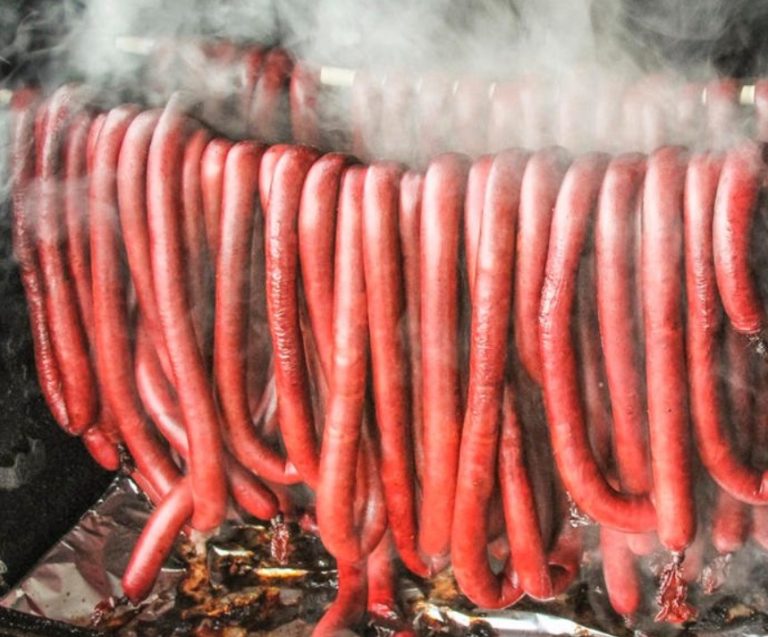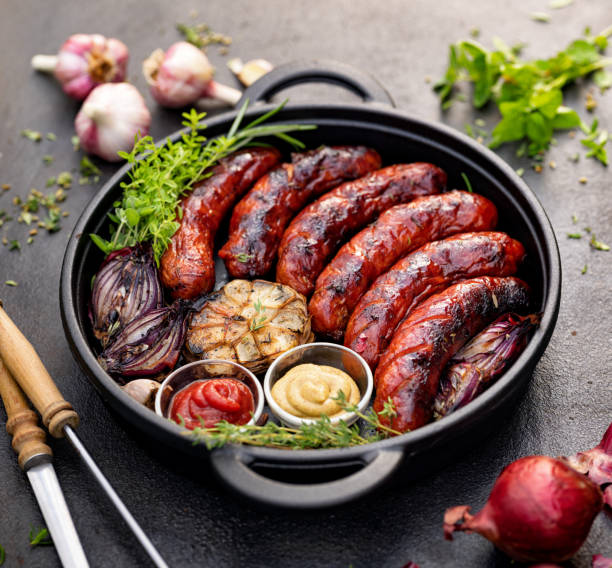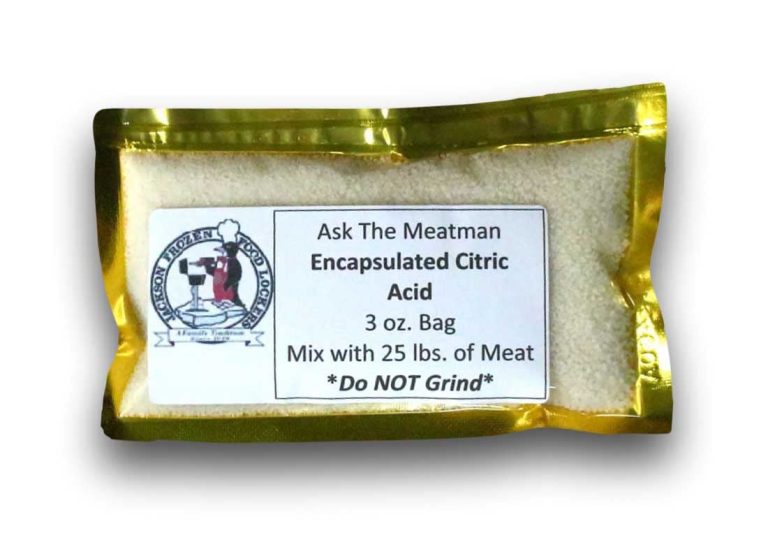Can You Eat Raw Salami?
There is a unique place in the cuisine of the US and Europe for the salami. Many people wonder if you can eat salami raw, as it consists of fermented and air-dried meat.
The FDA recommends you don’t eat raw salami because of potential health hazards.
If you want to try it, first make sure the salami is not expired. Then, it’s best to cook it, bake it, or marinate it to reduce the risks.
If the answer is yes, you would be able to have a delicious meal without cooking. We will find out more about the sausage and see if it is safe to eat raw.
Table of Contents
Is Salami Raw or Cooked?
Even though it is uncooked, it is not completely raw. It has a resemblance to raw meat due to its marbled appearance.
Salami comes in a variety of colors that are similar to the look of red meat. It doesn’t stay that way while it starts as raw in the early stages.
One of the reasons people think salami is raw is that it is stuffed with raw meat and requires cooking.
There are other similarities between raw sausage and salami. They comprise finely chopped or ground meat, spices, and fat.
They are also stuffed into various parts of the body. There are some obvious differences between the two. The raw sausage is duller and paler than any other sausage.
Italian variations include cooking in the manufacturing process. Cotto salami is smoked or cooked to give it a specific flavor after curing.
The food is not meant to be eaten without either of the procedures.

Is Salami Safe to Eat When Uncooked or Eaten Raw?
Many people are wondering how you can eat raw meat without getting sick. The answer is that it is safe to eat raw due to the way it is processed.
The production is divided into three stages: raw material preparation, fermentation, and drying.
The first phase includes grinding meat and mixing it with other ingredients like yeast, spices, sugar, and pepper. The food’s safety is more important than any of the other two stages.
The creation of the salami’s texture, flavor, and protection from harmful microbes can be accomplished through the use of fermentation.
Several chemical reactions are promoted within the meat. It can be hung in warm and humid conditions for up to three days.
The process of keeping salami fresh helps stave off harmful organisms. After that, the manufacturers add sugar to feed the curing bacteria.
The water-holding capacity of the salami is reduced due to the release of lactic acid by the microorganisms.
The acid makes the food hard to eat and it also makes the food hard to live with. It is necessary to dry the salami after it has been fermented.
There is a procedure that renders the casing reasonably airtight. A white cover of either flour or mold helps keep oxidation and fat rancidity at bay.
Drying and ripening are important factors that can cause water loss, forming a hard shell on the salami’s surface, and decreasing the risk of spoilage and disease.
Adding nitrates or nitrites to curing salts can provide extra color and help prevent the spread of bacteria.
It makes fully cured salami safe to eat because it combines salt, acidity, and dryness.

Common Signs of Salami Gone Bad
Color change
It is normal to see sections with white mold since the color of salami varies from dark red to light pink.
Good bacteria help to preserve salami and keep harmful bacteria from developing. The harmful microbes will grow over time if left open for too long.
They look like green, black, brown, or gray fuzzy spots. It’s okay to eat white fuzzy mold if you notice any of these spots.
Strange Smell
It is known for its distinct smell that is a bit cheese and acidic. It could even be similar to bleach. This is a big red flag in other foods and indicates that the item has gone bad.
These smells are fine because of the natural mold in salami.
Some strange smells are not good. If the salami stinks like rotten eggs or sewage, it’s time to throw it away.
Abnormal Texture
Spoilt salami is either slimy or hard to handle. A clear sign that it shouldn’t go near your mouth is each combination.
Even if you don’t like throwing out food, you are exposing yourself to serious health risks if you consume suspicious items.
FAQ
What Is the Main Difference Between Cured Salami and Uncured Salami?
One of the most significant differences between cured and uncured products is that uncured products feature natural curing substances, like celery powder, which are converted into nitrites when processed.
Cured salami comes with a label that says, “No nitrites or nitrates added except for those found naturally in celery juice or powder.
A unique texture is delivered by the slightly denser muscle fibers in the salted meat. The cured products are more yellow than the uncured ones.
It is possible to tell the difference between the two types of meat by checking the flavor.
Different tastes are created from the good bacteria, enzymes, and yeast, which are different from uncured versions.
The method of preservation is at the center of the distinction. Uncured salami uses natural flavors and salts, while cured sausages rely on chemicals and Additives.
Both types are offered by foodservice operators to give their customers multiple options.
Some people who are allergic to nitrates and nitrites opt for uncured salami since they think it is healthier.
This isn’t the case, but this isn’t the case. There is still uncured salami with nitrates.
The only difference is that they are derived from fruits and vegetables and turned into nitrites. These substances are in the form of man-made sodium nitrites.
How To Eat Uncured Salami?
There are two ways to eat uncured salami: cooked and raw. It is similar to cured sausage in that it contains the same substances to preserve the contents.
Uncured salami can be safe to eat for up to two months if it’s stored correctly. During this time, the meat maintains its peak quality, so it can be safe for even longer.
If you plan on freezing it, make sure it hasn’t been sitting in your fridge, otherwise, it can go bad.
Can You Eat Cold Salami?
It’s perfectly fine to eat cold salami. The whole point of the drying process is to turn fresh meat into food that can be eaten for several months without being refrigerated or frozen.
The risk of eating cold salami can be too great for some people. It should be avoided by pregnant women in particular.
There is a chance that the fetus can be harmed by the nitrates in the salami.
If the meat is homemade, it can also spread the nasty bacterium, Listeria. Between 12 and 30 days after consuming salami, there is a chance of a disease called Listeriosis.
It can cause defects in the fetus, as well as many other pregnancy problems. There is a possibility that undercooked salami is a source of Toxoplasma infections.
In addition, it can be passed on to the child, which can lead to learning disabilities, visual impairments, and even death.
The risk of food poisoning is another problem with poorly cooked salami.
On top of that, the food is high in salt and it hurts both the mother and child.
While eating from stores, carnivals, and street vendors is a hazard during pregnancy, even homemade products pose significant health risks, especially when undercooked.
The meat can be reheated until it starts steaming, but there is still a chance for it to be contaminated.
The way for another health problem is paved by the fact that cooking doesn’t remove nitrates.
Taking this into account, pregnant women should not eat cooked and cold salami.
Despite being delicious, it contains cholesterol and fat, which can lead to hypertension, diabetes, and heart disease.
It isn’t recommended that it has a high concentration of salt.
Does Salami Have to Be Cooked?
Unlike most meats, salami doesn’t have to be cooked. It is safe to consume raw due to the drying and fermentation processes that prevent bacteria from entering it.
If you want to make a sandwich or hot dish out of it, you can cook it enough to warm it up.
It doesn’t take long to cook, you just need to slightly brown the meat to bring out the delicious juices.
Roasted coppa and mortadella are two of the most well-known examples of cooked salami.
They come in smoked or cooked casings, and sometimes undergo curing, while other products aren’t cured or fermented during the production.
Another great idea is to fry some meat. It’s a simple practice that doesn’t require a lot of skill.
The only thing you need to do is drop your meat into a pan and wait for the edges to start curling up.
When the beef or pork fat is rendered out, it will begin to turn into a delicious dish. The cooked salami can last 14 days in your fridge and 7 days after you open it.
The best way to prolong its shelf life is to use the freezer. Two months is the length of time that frozen cooked salami can keep.
The shelf life of uncured salamis can be shortened due to the lack of artificial nitrates. It is best to check the use-by date on your packaging because their lifespan can vary greatly.
It can be eaten for six weeks or so if it is unrefrigerated and dry. You can keep it in the fridge indefinitely without being damaged.
It’s recommended that it be kept at room temperature for up to two hours. It shouldn’t be returned to the fridge if it stays in warm conditions for more than a few days.
You can keep sliced salami in your refrigerator for three weeks and in your freezer for two months. However, once cut, the meat can be contaminated by bacteria.
Tips on preserving Salami:
- It’s a good idea to store salami in the same conditions as red wine, between 59 and 64 degrees Fahrenheit and with 75% humidity.
- As a live product, it will cure (dehydrate) over time, and you will need to control its dehydration.
- Store it in a brown paper sandwich bag, which is porous and allows the meat to breathe, to promote this natural process.
- You can choose between dry tea towels or baking paper. During the cold months, you can hang or store the meat in your pantry.
- The best place to put the fridge is when the indoor temperature is consistently above 77 degrees Fahrenheit.
- The product is less desirable to consume if it is exposed to higher temperatures. The meat should be put in a container that is not plastic.
- Salami can be prevented from breathing and from drying. When you want to use some or all of it, leave it in the original packaging.
- Wrap the meat in something that does not cling wrap. If the trapped air is not stagnant then it will form mildew.
- Don’t remove an unnecessary amount of skin when you eat salami and eat it as soon as you cut it.
- It’s better to cut just enough to get the part of the salami you need. Even if you store the meat in the fridge, it will not last long without skin.
- After the salami is sliced, place it in the fridge and cover it tightly with appropriate materials around the cut surface.
Conclusion
Is it possible to eat a piece of meat raw? Yes, it is possible to eat this sausage without cooking it.
It undergoes stringent production to make sure no Microbe can hurt you while consuming it. If eating raw food isn’t your cup of tea, you can cook it or fry it.
You will receive stunning juices that can take the dish to a whole new level.
It is important to not eat too much salami. If you want to avoid unnecessary strain on your body, consume the right amount.

Foodie and a passionate cook, I am here to share all of what I know about cooking, kitchen, and food prepping.
Follow me for delicious and healthy recipes.






